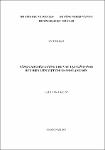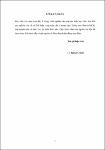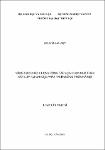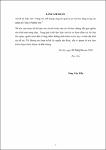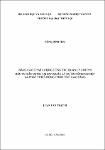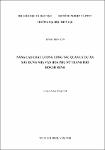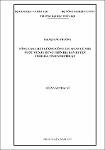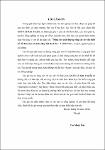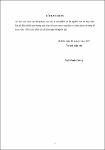- BB
Authors: Ellithy, Marwa Mohamed; Advisor: -; Participants: Aly, Riham Mohamed; Tarek, Heba El-Sayed (2022) - Rosemary nanoparticles composite characterization
Transmission electron microscope (TEM) informed us on the particle shape as well as their size. TEM micrographs of these nanoparticles are shown in Fig. 1. Electron microscopy analysis confirmed the presence of nanoparticles. RE-loaded chitosan nanoparticles were found to be spherical, distinct and regular with a size of 0.5 µm to 200 nm. Their surface is solid and has a dense structure. Chitosan nanoparticles appeared aggregated in the photomicrographs. The RE particles were well coated by chitosan. The particle size of the prepared nanoparticles ranged from 0.5 µm to 200 nm with an average size of 100 nm.
|
- BB
Authors: Kveladze, I.; Kraak, M.J.; Advisor: -; Participants: - (2017) - The Space–Time Cube (STC) is a suitable representation to display multiple characteristics of movement data and will especially reveal temporal patterns in the data. By adding annotations to the cube’s paths and stations, the narrative of the display is enhanced. To illustrate the STC’s storytelling capabilities, a historical event, Napoleon’s crossing of the Berezina River during his Russian campaign in 1812 is presented and linked to an event in 2012 when the authors made a similar trip. Also, a set of different visual queries and their results are presented, emphasizing the STC as an alternative addition to a more extended visualization environment.
|
- BB
Authors: Tompoulidou, M.; Advisor: -; Participants: - (2016) - A key issue in modern fire management planning is the accurate fuel type mapping, required at many different spatial and temporal scales. Fuel type classification is critical for improving fire prevention schemes, developing accurate fire dispersion models and designing effective measures for mitigating the impacts of a potential wildfire event on the ecosystem. Remote sensing offers the potential to provide spatially distributed information on fuel types and it has been widely used both at regional and local scale. The aim of this study is to develop and evaluate a fuel type mapping methodology on a national level, based on the geographic objectoriented classification approach and La...
|
- BB
Authors: Köllen, Thomas; Advisor: -; Participants: Koch, Andri; Hack, Andreas (2019) - -
|
- BB
Authors: Abd-El-Kareem, Farid; Advisor: -; Participants: Elshahawy, Ibrahim E.; Abd-Elgawad, Mahfouz M. M. (2022) - Increasing cultivation of strawberry in Egypt has boosted efforts to increase its yield. Biocontrol agents (BCAs) may avoid side effects and health risks caused by chemical fungicides used to control black root rot disease in strawberry. Some BCAs control the disease and augment strawberry yield, but additional research is needed to fit BCAs into emerging control strategies. The impact of six bacterial isolates of Paenibacillus polymyxa and Bacillus brevis on this disease and on berry yield is reported and compared to a common chemical fungicide.
|
- BB
Authors: Majumder, Soumya; Advisor: -; Participants: Ghosh, Arindam; Bhattacharya, Malay (2020) - A total of twenty-nine anti-inflammatory compounds, occupying 83.96% of total area, came out in the result. Most of the metabolites are terpenoids leading with triterpenoids like squalene, lupeol, and vitamin E. In this study, the candidate molecules responsible for anti-inflammatory activity were spotted out in the leaf extract and biosynthetic relation or interactions between those components were also established.
|
- BB
Authors: Rocard, J.M.; Advisor: -; Participants: Asadishad, B.; Samonte, P.R.V.; Ghoshal, S.; Tufenkji, N. (2018) - We investigated the influence of temperature fluctuations around the freezing point, known as freeze-thaw (FT), on the inactivation rates, growth, and biofilm formation of a manure-isolated strain of Salmonella typhimurium. Moreover, the effects of FT on the transport characteristics of S. typhimurium in quartz sand were monitored in model porewater solutions of two different ionic strengths (IS: 10 and 100 mM KCl) and two different humic acid (HA) concentrations (1 and 5 mg/L). Increasing numbers of FT cycles were found to decrease the deposition of S. typhimurium onto quartz sand and increase the percentage of detached cells in sand-packed column experiments. Based on the calculated...
|
- LA
Authors: Vy, Tiến Đạt; Advisor: Phạm, Hùng; Participants: - (2017) - Những vấn đề cơ bản về chất lượng cho vay của ngân hàng thương mại. Thực trạnh chất lượng cho vay của ngân hàng thương mại CP Bưu điện Liên Việt nhánh Lạng Sơn. Giải pháp nâng cao chất lượng cho vay của Ngân hàng TMCP Bưu điện Liên Việt chi nhánh Lạng Sơn
|
- LA
Authors: Lê, Nguyên Hoài; Advisor: Đinh, Thế Mạnh; Participants: - (2017) - Tổng quan về công tác giám sát thi công các công trình xây dựng. Cơ sở khoa học và pháp lý về công tác giám sát thi công các công trình xây dựng. Đề xuất giải pháp tăng cường công tác giám sát thi công công trình hạ tầng kỹ thuật thuộc dự án tái định cư xã Hồng Tiến.
|
- LA
Authors: Phạm Nguyễn Nhật Trường; Advisor: Nguyễn Trọng Tư; Participants: - (2021) - -
|
- LA
Authors: Nguyễn, Hà Việt; Advisor: Dương, Đức Tiến; Participants: - (2018) - Nghiên cứu đánh giá thực trạng công tác đấu thầu, các văn bản qui phạm, qui trình và nội dung về đấu thầu. Từ đó đề xuất các giải pháp nhằm nâng cao chất lượng công tác lựa chọn nhà thầu trong lĩnh vực xây lắp của chi cục phát triển nông thôn Hà nội.
|
- LA
Authors: Lê, Văn Hùng; Advisor: Lê, Xuân Roanh; Participants: - (2019) - Xây dựng phương pháp luận về đánh giá chất lượng công trình trong giai đoạn vận hành khai thác. Đánh giá thực trạng chất lượng công trình tại công ty TNHH MTV thủy lợi Tây Bắc Nghệ An. Đề xuất một số giải pháp quản lý chất lượng công trình thủy lợi trong giai đoạn vận hành khai thác tại công ty
|
- LA
Authors: Nông, Văn Tiến; Advisor: Lê, Xuân Roanh; Participants: - (2018) - Phân tích đánh giá thực trạng công tác quản lý an toàn lao động trong xây dựng tại công ty Nghĩa Sơn. Đề xuất các giải pháp nhằm nâng cao chất lượng công tác quản lý an toàn lao động trong xây dựng tại công ty Nghĩa Sơn.
|
- LA
Authors: Nông, Đình Hòa; Advisor: Đinh, Thế Mạnh; Participants: - (2018) - Phân tích đánh giá thực trạng công tác quản lí chi phí đầu tư xây dựng công trình tại Ban quản lí dự án Nông nghiệp và phát triển nông thôn tỉnh Cao Bằng. Qua đó đề xuất một số giải pháp nhằm góp phần nâng cao chất lượng công tác quản lí chi phí cho Ban quản lí dự án.
|
- LA
Authors: Đinh, Thiên Tân; Advisor: Đinh, Thế Mạnh; Dương, Đức Tiến; Participants: - (2019) - Phân tích đánh giá thực trạng công tác quản lý dự án đầu tư xây dựng công trình sử dụng nguồn vốn ngân sách nhà nước tại dự án "Xây dựng nhà Văn hóa Phụ nữ thành phố Hồ Chí Minh". Đề xuất giải pháp nhằm hoàn thiện công tác QLDA đầu tư xây dựng công trình sử dụng vốn NSNN tại Thành phố Hồ Chí Minh
|
- LA
Authors: Đạo, Quang Trưởng; Advisor: Tạ, Đình Phấn; Participants: - (2017) - Nghiên cứu thể chế, cơ chế, chính sách , nội dung..trong công tác quản lý nhà nước về xây dựng nói chung và trật tự xây dựng đô thị nói riêng trên địa bàn huyện Hải Ninh. Qua đó đề xuất một số giải pháp nhằm nâng cao công tác quản lí xây dựng trên địa bàn huyện.
|
- LA
Authors: Nguyễn, Tiến Trịnh; Advisor: Đinh, Thế Mạnh; Participants: - (2019) - Cơ sở lý luận và thực tiễn về chất lượng cán bộ chủ chốt cấp xã. Thực trạng chất lượng cán bộ chủ chốt cấp xã của huyện Võ Nhai. Một số giải pháp nhằm nâng cao chất lượng đội ngũ cán bộ chủ chốt cấp xã của huyện Võ Nhai, tỉnh Thái Nguyên.
|
- LA
Authors: Tào, Mạnh Đức; Advisor: Lê, Kim Truyền; Participants: - (2014) - Đặc điểm, điều kiện làm việc của đập đất và những nguyên nhân gây ra sự cố làm mất an toàn đập đất; quản lý chất lượng tư vấn thiết kế để chủ động đảm bảo an toàn đập đất; những giải pháp bảo đảm chất lượng hồ sơ thiết kế đập Ba Cầu - Thanh Hóa.
|
- LA
Authors: Nguyễn, Hữu Thứ; Advisor: Lê, Trung Phong; Participants: - (2019) - Phân tích đánh giá thực trạng công tác quản lý dự án, chất lượng dự án của hệ thống đê sông Nghệ An. Đề xuất một số giải pháp có sơ sở khoa học và thực tiễn nhằm tăng cường công tác quản lý chất lượng dự án đầu tư xây dựng. Áp dụng đánh giá mức độ an toàn của hệ thống đê sông khu vực thành phố Vinh
|
- LA
Authors: Ngô, Mạnh Cường; Advisor: Vũ, Thanh Te; Participants: - (2017) - Tổng quan về công tác đấu thầu và chất lượng công tác đấu thầu xây dựng. Một số ván đề lý luận chung về công tác đấu thầu và chất lượng quản lý công tác đấu thầu trong xây dựng. Đề xuất một số giải pháp nâng cao chất lượng công tác đấu thầu tại Ban quản lý dự án đầu tư xây dựng thành phố Bắc Giang.
|



